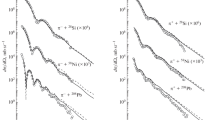Abstract
The dynamics of pion-nucleon scattering in the S 11 and S 31 states has been investigated on the basis of the analytical approach to construction of operators of effective interactions between compound systems of strongly interacting particles with allowance for inelasticity effects at incident pion kinetic energies T < 1.5–2.5 GeV. Information about the structure of discontinuities of partial πN-scattering amplitudes in the states under consideration is derived using the available phase-shift data and effective local potentials are constructed by solving the inverse scattering problem. The possibility of description of discontinuities of partial amplitudes at dynamical cuts using exchange mechanisms in the t-and u-scattering channels and contact interactions of the Lagrangian of the chiral perturbation theory is analyzed.
Similar content being viewed by others
References
Olsson, M.G. and Osypowski, E.T., Nucl. Phys. B, 1975, vol. 101, p. 136.
Pearce, B.C. and Jennings, B.K., Nucl. Phys. A, 1991, vol. 528, p. 655.
Gross, F. and Surya, Y., Phys. Rev. C: Nucl. Phys., 1993, vol. 47, p. 703.
Goudsmit, P.F.A. et al., Nucl. Phys. A, 1994, vol. 575, p. 673.
Suchütz, C., Haidenbauer, J., Speth, J., and Durso, J.W., Phys. Rev. C: Nucl. Phys., 1998, vol. 57, p. 1464.
Sander, M. and von Geramb, H.V., Phys. Rev. C: Nucl. Phys., 1997, vol. 56, p. 1218.
Coronos, C. and Landau, R.H., Phys. Rev. C: Nucl. Phys., 1981, vol. 24, p. 605.
Landau, R.H. and Tabakin, F., Phys. Rev. C: Nucl. Phys., 1972, vol. 5, p. 2746.
Weinberg, S., Nucl. Phys. B, 1991, vol. 363, p. 3.
Cahill, R.T., Nucl. Phys. A, 1992, vol. 543, p. 63.
Torikoshi, K. and Ellis, P.J., Phys. Rev. C: Nucl. Phys., 2003, vol. 67, 015208.
Ellis, P.J. and Tang, H.-B., Phys. Rev. C: Nucl. Phys., 1998, vol. 57, p. 3356.
Fettes, N., Meiner, U.-G., and Steininger, S., Nucl. Phys. A, 1998, vol. 640, p. 199.
Bernard, V., Kaiser, N., and Meiner, U.-G., Nucl. Phys. A, 1997, vol. 615, p. 483.
Safronov, A.N. and Safronov, A.A., Yad. Fiz., 2006, vol. 69, p. 408 [Phys. At. Nucl. (Engl. Transl.), vol. 69, p. 384].
Safronov, A.N. and Safronov, A.A., Izv. Akad. Nauk, Ser. Fiz., 2004, vol. 68, no. 8, p. 1195.
Safronov, A.N. and Safronov, A.A., Izv. Akad. Nauk, Ser. Fiz., 2006, vol. 70, no. 2, p. 258.
Landau, L.D., Zh. Eksp. Teor. Fiz., 1959, vol. 37, p. 62 [Sov. Phys. JETP (Engl. Transl.), vol. 10, p. 45].
Collins, P.D.B. and Squires, E.J., Regge Polesin Particle Physics, Berlin: Springer Verlag, 1968. Translated under the title Polyusa Redzhe v fizike chastits, Moscow: Mir, 1971.
Eden, R.J., High Energy Collisions of Elementary Particles, Cambridge: Univ. Press, 1967.
Cutkosky, R.E., J. Math. Phys., 1960, vol. 1, p. 429.
Marchenko, V.A., Dokl. Akad. Nauk SSSR, 1955, vol. 104, p. 695.
Chadan, K. and Sabatier, P.C., Inverse Problems in Quantum Scattering Theory, Berlin: Springer Verlag, 1977. Translated under the title Obratnye zadachi v kvantovoi teorii rasseyaniya, Moscow: Mir, 1980.
Shirkov, D.V., Serebryakov, V.V., and Meshcheryakov, V.A., Dispersionnye teorii sil’nykh vzaimodeistvii pri nizkikh energiyakh (Dispersion Theories of Strong Interactions at Low Energy), Moscow: Nauka, 1967.
Arndt, R.A. et al., computer code SAID, online program at http://gwdac.phys.gwu.edu.
Safronov, A.N. and Safronov, A.A., Yad. Fiz., 2004, vol. 67, p. 2269 [Phys. At. Nucl. (Engl. Transl.), vol. 67, p. 2245].
Krehl, O., Hanhart, C., Krewald, S., and Speth, J., Phys. Rev. C: Nucl. Phys., 2000, vol. 62, 025 207.
Author information
Authors and Affiliations
Additional information
Original Russian Text © A.N. Safronov, A.A. Safronov, 2007, published in Izvestiya Rossiiskoi Akademii Nauk. Seriya Fizicheskaya, 2007, Vol. 71, No. 6, pp. 889–896.
About this article
Cite this article
Safronov, A.N., Safronov, A.A. Analytical approach to the problem of constructing operators of effective pion-nucleon interaction at low and intermediate energies. Bull. Russ. Acad. Sci. Phys. 71, 861–868 (2007). https://doi.org/10.3103/S1062873807060214
Issue Date:
DOI: https://doi.org/10.3103/S1062873807060214




